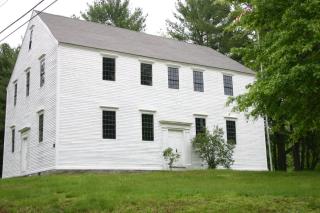Historic District

Nestled along both sides of Main Street in North Danville lies a special place that is now Danville's Historic District. The district was established by the town voters in 1999 and is overseen by the Heritage Commission under Article XIII of the Danville Zoning Ordinance. The properties in the Historic District are currently listed in Article III. E. of the Ordinance.
For more than two centuries this area has been used, worked, tended, preserved and passed down through the generations, partly by town government and partly by early settlers and their descendants. This special place represents the nucleus of the Town of Danville’s earliest government and community center and the working lands of some of the families who made it happen. This special place reflects the commitment of this town’s early settlers to establish a free, independent, self-sufficient and beneficial community. The Town of Danville owns the Old Meeting House, Parsonage lots, cemeteries and, through twists of fate, almost 400 acres of land in this special place.
Danville, known as Hawke until 1836, was part of Kingston prior to 1760. In those times travel was chiefly by foot. Horses were expensive and rare. People would spend entire days in their meeting houses for worship and government. Travel from Hawke to Kingston for worship and other purposes was hard and difficult. The people of Hawke wanted their own community where they could worship and govern close by. Yet a number of things were required before a community could prove that it was able to stand on its own. Among these were a meeting house, a minister, community wood lots or parsonage lots, and a mill to cut lumber for new homes of settlers.
Twenty-seven private citizens undertook the building of Danville’s meeting house in 1755. It is the town’s historical crown jewel. The meeting house was standing by 1760 and more than 200 area residents petitioned for permission to be set off as an independent community from Kingston. When permission was granted in February, 1760, the twenty-seven original builders donated the meeting house to the town, then known as the Parish of Hawke. Listed in the National Register of Historic Place since 1982, this building is the oldest original construction meeting house in the State of New Hampshire.
Across the street from the Meeting House lies Tuckertown Road, stretching from Main Street to the Sandown line. Records indicate this was the first official highway layout by the selectmen of Hawke in 1766. It was also a place of great tragedy. A terrible smallpox epidemic struck in the winter of 1781-1782. The town’s first and much loved minister, the Rev. John Page, became ill while he was tending to sick members of the Tucker family, who lived at the end of Tuckertown Road. The Rev. Page quarantined himself in an empty cabin on Tuckertown Road, where he passed away. His body was drawn out by sled and buried in Ye Olde Cemetery, one-tenth of a mile north of the Meeting House on the west side of Main Street. No residences were ever established on Tuckertown Road after the Rev. Page’s death. Over the years the voters of Danville have designated the road closed, scenic and a Class A trail. Today the nature, appearance, width and general ambiance of Tuckertown Road provides an aesthetic link to 18th century times as the town was being settled.
Two of Danville’s oldest cemeteries also grace this special place: Ye Old Cemetery with burials dating from 1740, and the Old Meeting House Cemetery with burials dating from 1817 to present. Both cemeteries are the burial sites of settlers and their descendants.
A little to the north on the opposite side of Main Street lies one of Danville’s two original Parsonage Lots. One of the requirements for an independent community were community wood lots which were to be used to provide housing and heat for the required minister. The Parsonage Lots in Danville were managed for centuries to raise additional community funds through harvesting and timber auctions and rental of the land for planting and grazing. Danville’s “Parsonage Lots” have sometimes caught the attention of the media. One written article referred to the land as the oldest town forest in the country. Danville’s “forest” was once mentioned in a Reader’s Digest article which reported “the town has operated 77 acres of forest land almost from its settlement in 1760…the returns have been used for the support of the minister and the parish.” In a 1938 radio interview about town forests on the National Farm and Home Hour, the then Chief of the U.S. Forest Service said town forests were managed for many community benefits—places to go, fishing and income. He gave Danville, New Hampshire as an example of a New England town that derived income from its forest.
Today most of the lands which comprised the original nucleus of Hawke are town-owned and as such provide a nostalgic and historic glimpse for residents and visitors alike into the center of Danville’s town origins.

